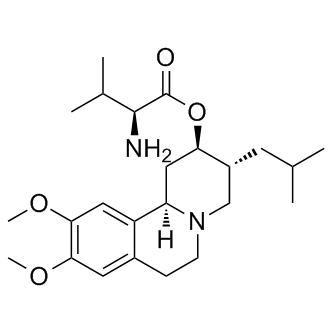
Valbenazine
CAS No. 1025504-45-3
Valbenazine( NBI-98854 )
Catalog No. M10117 CAS No. 1025504-45-3
A novel, highly selective vesicular monoamine transporter 2 (VMAT2) inhibitor; is approved for the treatment of tardive dyskinesia.
Purity : >98% (HPLC)
 COA
COA
 Datasheet
Datasheet
 HNMR
HNMR
 HPLC
HPLC
 MSDS
MSDS
 Handing Instructions
Handing Instructions
| Size | Price / USD | Stock | Quantity |
| 2MG | 60 | In Stock |


|
| 5MG | 122 | In Stock |


|
| 10MG | 177 | In Stock |


|
| 25MG | 402 | In Stock |


|
| 50MG | 582 | In Stock |


|
| 100MG | 831 | In Stock |


|
| 200MG | Get Quote | In Stock |


|
| 500MG | Get Quote | In Stock |


|
| 1G | Get Quote | In Stock |


|
Biological Information
-
Product NameValbenazine
-
NoteResearch use only, not for human use.
-
Brief DescriptionA novel, highly selective vesicular monoamine transporter 2 (VMAT2) inhibitor; is approved for the treatment of tardive dyskinesia.
-
DescriptionA novel, highly selective vesicular monoamine transporter 2 (VMAT2) inhibitor; is approved for the treatment of tardive dyskinesia.Other Indication Phase 3 Clinical(In Vitro):Valbenazine exhibits VMAT2 binding affinity in rat striatum and human platelets with Kis of 110 and 150 nM, respectively. (In Vivo):Valbenazine (10 mg/kg; orally) induces ptosis (primarily an adrenergic response) and increases plasma prolactin primarily a dopaminergic response.
-
In Vitro——
-
In Vivo——
-
SynonymsNBI-98854
-
PathwayOthers
-
TargetOther Targets
-
RecptorOther Targets
-
Research AreaOther Indications
-
IndicationOther Disease
Chemical Information
-
CAS Number1025504-45-3
-
Formula Weight418.5695
-
Molecular FormulaC24H38N2O4
-
Purity>98% (HPLC)
-
Solubility10 mM in DMSO
-
SMILESCC(C)CC1CN2CCC3=CC(=C(C=C3C2CC1OC(=O)C(C(C)C)N)OC)OC
-
Chemical NameL-Valine, (2R,3R,11bR)-1,3,4,6,7,11b-hexahydro-9,10-dimethoxy-3-(2-methylpropyl)-2H-benzo[a]quinolizin-2-yl ester
Shipping & Storage Information
-
Storage(-20℃)
-
ShippingWith Ice Pack
-
Stability≥ 2 years
Reference
1. O'Brien CF, et al. Mov Disord. 2015 Oct;30(12):1681-7.
molnova catalog



related products
-
Methylene Blue trihy...
A compound consisting of dark green crystals or crystalline powder, having a bronze-like luster.
-
N-Methyl-N-(trimethy...
Used as organic synthesis and medicine intermediate.
-
Adrenocorticotropic ...
Adrenocorticotropic Hormone (ACTH) (1-39), rat is a potent melanocortin 2 (MC2) receptor agonist.Peptide fragments of ACTH (1-39) were formed during in vitro incubation of the peptide with membrane preparations. ACTH (1-39) were isolated by high pressure liquid chromatography, and peptide fragments of ACTH (1-39) characterized by determination of amino acid composition and NH2- terminal residue.



 Cart
Cart
 sales@molnova.com
sales@molnova.com


